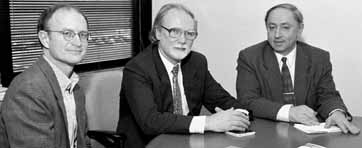 |
|
Northern Lights by Judy Jackson
But for some Stockholm physicists these days, Fermilab is the destination of choice. That's where they pass out the high-energy protons.
As Fermilab's detector collaborations race to prepare for the upcoming collider run at the Tevatron, physicists from Sweden's Stockholm University are among the dozens of collaborators hard at work on DZero's Silicon Vertex Detector, assembling and installing the intricate marvel of leading-edge technology that will operate at the heart of that collaboration's 5000-ton detector. They are among the many hundreds of scientists from institutions in 16 nations who have joined in the physics adventure called Run II, at the energy frontier.
Meanwhile, around the Tevatron ring at CDF, another northern contingent, this one from the Joint Institute for Nuclear Research, in Dubna, Russia, 130 kilometers north of Moscow, watched with satisfaction this fall as the eight tons of scintillation counters that they built and delivered to Fermilab passed the test of CDF's recent commissioning run with flying colors. Six hundred and seven units of scintillating counters made of fibers from the Ukraine, assembled in Russia and air-freighted to Fermilab, are now an integral part of the $100 million CDF upgrade that researchers hope will discover new knowledge about what the universe is made of and how it works.
Why have these scientists come from their lands of snowflakes and birch trees to our land of snowflakes and protons? Hint: It's not the snowflakes.
"The Tevatron is the best place to continue the study of matter."
Barbro Asman, of Stockholm University, agreed.
"For high-energy physicists," she said, "Run II at the Tevatron will produce the most interesting physics in the world, for at least the next five years."
Asman is eager to ensure that Swedish physicists and graduate students have access to the discovery opportunities that data from the Tevatron will provide. Besides collaborating on Fermilab's DZero experiment, Stockholm is also a member of DELPHI, one of four collider experiments at the Large Electron Positron Collider at CERN, the European Laboratory for Particle Physics. However, a recent statement from CERN's Committee of Council that "terminates the LEP data-taking and moves us into the LHC era," means that DELPHI's data-taking days are now over. The half-dozen years before high-energy collisions at CERN begin again at the Large Hadron Collider are too long for thesis-bound students to wait. So, like hundreds of their fellow physicists worldwide, they have decided to come to Fermilab, where, starting next March, high-energy protons will once again be blazing a trail to the heart of matter.
The Stockholm researchers will concentrate their Run II analysis efforts on the search for Supersymmetry, ‰sman said, although "exactly where we haven't figured out." She expects that as many as 12 Swedish physicists and students will ultimately become DZero collaborators.
At CDF, Budagov said, the Dubna group will concentrate on the physics of the top and b quarks. Besides the better-known Higgs and SUSY searches, experimenters expect that the new capabilities conferred by CDF's SVX silicon detector, to which Dubna scientists contributed, will open up exciting new vistas in b physics for Run II.
"We'll be working night shifts, day shifts, 120 percent," Budagov said. "New physics is target number one."
Dubna, the home of the Joint Institute for Nuclear Research, has a proud tradition of forefront research in the physical sciences, and in fact Dubna scientists also collaborate at DZero. Budagov wears a watch commemorating the 50th anniversary of accelerator operation at the laboratory, located at the confluence of the Volga, Dubna and Sestra Rivers. In a symbol of the survival of experimental physics through difficult times, that 50-year-old accelerator, the 680 MeV synchrocyclotron, once the world's most powerful particle accelerator, is still operating today.
Budagov described JINR, founded in 1956, as a sort of Eastern Bloc version of CERN, with member states including Russia, Ukraine, Belarus, Armenia, Kazakhstan, Uzbekistan, Azerbaijan, Poland, Georgia, the Czech Republic, Bulgaria, Slovakia, North Korea and, most recently, Vietnam, among others. The Dubna laboratory currently operates active programs in particle physics, nuclear physics and condensed matter physics.
After a number of extraordinarily difficult years for physics research in Russia and other former Soviet member states, the future of JINR at Dubna is now looking somewhat brighter. A January 2000 law recognized JINR as an international organization on Russian soil and provided for significant ongoing financial support from the Russian government. Member states contribute to its operation.
Scientists from JINR are active on forefront physics experiments worldwide. But just how did Dubna scientists wind up at CDF?
"Everything starts with friendship, with personal relationships," Budagov said. Collaborations at Brookhaven National Laboratory and at the late lamented Superconducting Super Collider led to friendships and working relationships among Dubna scientists and American physicists, and to an especially close collaboration with Italian physicists from Pisa, who are themselves charter CDF members.
"We came to CDF through the Dubna-Pisa connection," Budagov said. "Science brings nations together."
At DZero, Stockholm's Asman echoes his sentiments.
"For us, DZero feels like a good fit," she said. "We're from Sweden, but we feel very much at home at Fermilab." |
| last modified 12/1/2000 email Fermilab |
FRLsDFx9eyfrPXgV
 Stockholm is every physicist's dream destination. That's where they pass out the Nobel Prizes.
Stockholm is every physicist's dream destination. That's where they pass out the Nobel Prizes.
 It's simple, said Julian Budagov, leader of the CDF Dubna group.
It's simple, said Julian Budagov, leader of the CDF Dubna group.